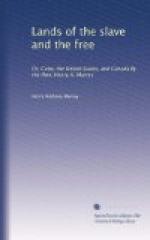“In America all conveyances of land, whether absolute or by way of mortgage only, are, with the exception of some chattel interests, required to be registered within a fixed or a reasonable time after their execution. Registration is constructive notice to all the world; if not registered, a deed is only valid against the parties to it and the heirs and devisees of the grantor. Generally, however, notice obtained by a purchaser previous to his purchase, will, if clearly proved, prevent his taking the advantage, though he may have been beforehand in registering his own title.
“By the old laws of Massachusetts, all deeds of conveyance were required to be recorded, ’that neither creditors might be defrauded, nor courts troubled with vexatious suits and endless contentions.’ In consequence of the number of registers established in each county—and the excellence of their arrangements, no inconvenience results from the accumulation of deeds, notwithstanding the early period to which they go back. In register for Suffolk county, Massachusetts, are to be seen copies of deeds from 1640 down to the present time. They are bound up in 640 volumes, and do not as yet take up much space. They have lately multiplied in an increasing ratio, the volumes having risen from 250 to their present number in the last 25 years.
“The register for Philadelphia county, Pennsylvania, contains within a moderate compass deeds from 1683 downwards. They are referred to by indices on the following plan: All deeds made within a certain time, and in which the name of the grantor commences with the same letter of the alphabet, are bound up in one volume; thus, a volume marked “H 1820-1847,” contains all deeds executed between those years by grantors whose names begin with H. One index volume contains the names of all grantors between those years in alphabetical order, another that of all grantees, and both refer to volume and page of the books of deeds. A third index gives the names of grantors and grantees, arranged chronologically, according to the year in which the deed they were parties to was executed.
“The original deed remain in the possession of the proprietors, but are of secondary importance. They are written in a plain, legible hand on paper, parchment being seldom used. The signatures of the parties are of course requisite; but the seal, which is essential to a deed in England, is in many States dispensed with. The custom of registering obviates the necessity for those long recitals that so swell out an English conveyance, and the shortest possible forms of covenants are preferred. The American conveyance only witnesses that the grantor conveys the property therein described, which, or part of which, was conveyed to him by such a one by a deed of such a date, and a marginal note states the volume and page where the deed thus mentioned is to be seen.




